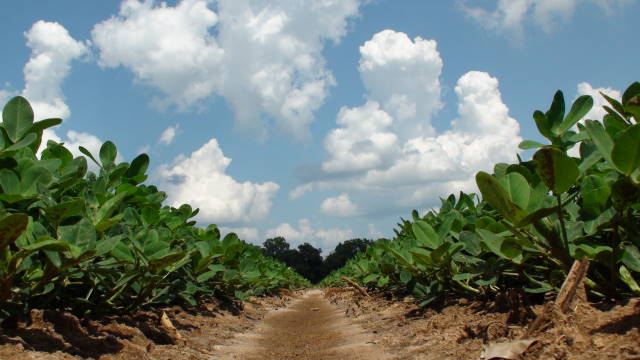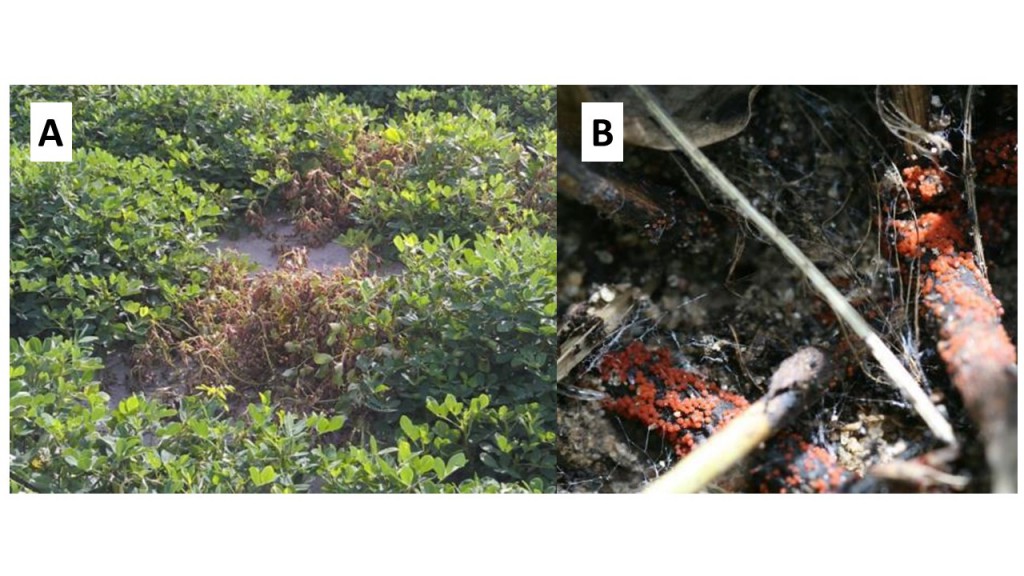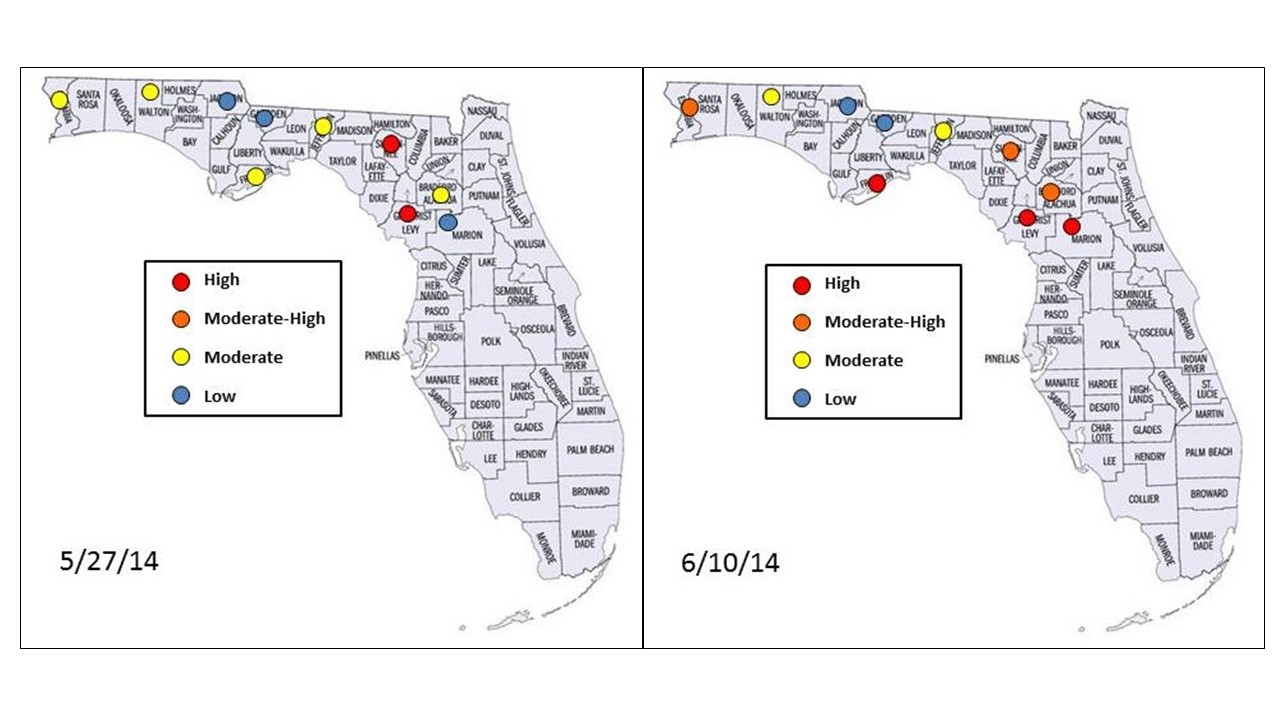
Environmental conditions as well as field history are critical factors in developing your peanut fungicide prescription. Photo by John Atkins.
In recent years, we have heard about the benefits of early season fungicide sprays for the products Proline® and Abound®. These sprays typically occur between 20 and 40 days after planting which is more or less the current status of many peanut fields in Florida. So, should we spray or not spray?
In order to answer this question we need to ask a few more. What disease do we intend to manage with the spray and what is the risk for disease? Generally, these early season fungicide sprays are applied to manage the soil borne pathogen Sclerotium rolfsii, which causes white mold on peanuts. However, an early season in-furrow application of Proline® can provide improved management of Cylindrocladium Black Rot (CBR). So, to answer our first question, these sprays should be focused on either white mold management or CBR management.

Typical symptoms and signs of white mold in peanuts. Plants typically wilt in the upper portion (A) producing a “shepards crook” appearance and often white fungal growth (B) which can be seen on the stem and crowns of the plants. Tan to light brown sclerotia, which resemble mustard seeds, can also be found near the crown.

Typical symptoms and signs of CBR in peanuts. Plants typically wilt and die (A) and often red fungal structures called perithecia (B) can be seen on the stem and crowns of the plants.
Assessing the risk of white mold and CBR can be done by examining the field history and through the use of the decision support tool Peanut Rx (page 38). If the field of interest has a history of either or both diseases and Peanut Rx indicates a high risk for these pathogens then it might be time to consider an early fungicide application. However, environmental conditions are also important when assessing risk. CBR disease development is favored by cooler soil temperatures and increased rainfall at planting and throughout the first few weeks after planting. White mold, on the other hand, is favored by warmer soil temperatures at and after planting. Recently, a decision support tool was developed at the University of Florida that provides further insight into periods of when environments are optimal for white mold growth and development.
The White Mold Risk Assessment Tool (WMRAT) is based on the concept that fungal growth is more likely to occur on days in which optimal soil temperatures and moisture are present during the majority of day. This tool is still in the experimental phase, but it is the goal of researchers to have the beta-WMRAT accessible through the peanutFARM website by the end of 2014. Multiple field trials are being conducted this year to test WMRAT in Florida and its effectiveness in assisting with white mold spray decisions. Preliminary results from the WMRAT can be seen in the figure below. Overall, the WMRAT indicates that until recently soil temperature conditions have not been optimal for white mold development across a majority of the peanut producing regions. Current national weather forecasts indicate that air temperatures across Florida will remain cool (highs < 90 F) for about another week, which means that the risk ratings in many areas may drop. However, once these temperatures get above 90 F, it can be expected that risk levels will increase, and could be similar to the ones shown on the June 10 risk assessment map. Basically, the WMRAT indicates that soil conditions are beginning to become optimal for white mold development. However, unless the field of interest has a high risk for White Mold based on field history and Peanut Rx, the recommendation would be to limit early season applications for white mold. For example, based on the following maps, an early season spray would not be recommended in Jackson and Gadsden counties because they show a low level of potential white mold growth periods.

Experimental results from the white mold risk assessment tool (WMRAT) for the specified dates. The different risk levels associated with environmental periods considered optimal for white mold growth are listed in the legend as High, Moderate-High, Moderate and Low. Circles on the maps mark the points where weather data from the Florida automated weather network was collected and used in WMRAT.
The final question in determining if a spray is useful is cost. This is a difficult question to answer and will vary from farm to farm. Both Proline® and Abound® will help manage leaf spot problems in peanuts, but it is always good to consider mixing these products with another product (e.g. Chlorothalonil) for optimal leaf spot control. Ultimately, the benefits and risks associated with spraying versus not spraying need to be considered for each individual production system. The tools and information provided here should be used as a guide to make informed spray management decisions. The WMRAT is an experimental tool used to provide information about in season environmental conditions affecting white mold growth. For more information about WMRAT or early season fungicide sprays contact Dr. Nicholas Dufault (nsdufault@ufl.edu) or your local extension office.
- 2025 End-of-Season Florida Peanut Disease Notes - October 24, 2025
- Southern Rust Confirmed in the Florida Panhandle – June 2025 - June 6, 2025
- Stay Ahead of Disease with the Spore Report: A New Tool to Assist with Potato and Watermelon Management - April 11, 2025
